Transcription of Strategies for optimizing your accounts payable
1 Make your working capital work for youStrategies for optimizing your accounts payablePart of the Deloitte working capital series2 The Deloitte working capital seriesStrategies for optimizing your accounts receivableStrategies for optimizing your accounts payableCash managementStrategies for optimizing your inventoryStrategies for optimizing your accounts payable 1In today s business climate, organizations in every sector are under pressure to do more with less. That means businesses cannot afford to squander opportunities to free up their working capital. By giving you greater availability to the cash trapped on your balance sheet, a formal working capital strategy can deliver the added liquidity you need to fund growth, streamline processes, reduce costs, enhance service levels and seize new investment opportunities as they there are numerous ways to free up working capital, this series focuses on four core Strategies : accounts receivable, accounts payable , cash management and inventory.
2 This second installment looks at accounts Ta k ing a strategic approach to accounts payable managementStrategies for optimizing your accounts payable 3 Because accounts payable is a back-office function, it doesn t always take centre stage as businesses look to grow or build competitive advantage. In fact, often accounts payable takes a back-seat to management s competing priorities. When it comes to working capital optimization, however, increasing payables should be a core strategy. To be sure, many businesses work this strategy by extending payables as long as possible to maximize free cash flow.
3 Unfortunately, this approach is not always the right one. In some cases, delaying payment can erode supplier goodwill, resulting in slower delivery times, less willingness to fix defects, slower responses to queries and more onerous payment terms. On the flip side, paying early can sometimes yield substantial benefits in situations where suppliers offer discounts or rebates for early payment. To effectively identify these opportunities and determine the right course of action when facing potentially conflicting outcomes, businesses must take a more strategic approach to accounts payable .
4 The accounts payable team, along with the Purchasing and/or Procurement departments, must collaborate with senior management to inject a working capital culture throughout the company. This is about more than ensuring invoices are received and processed in a timely fashion. It s about adopting a management focus that emphasizes the importance of optimizing payables and freeing up working capital to fuel Adopting best practicesWhile organizational change is rarely easy, fostering a working capital culture can yield sizeable benefits. For instance, refining your accounts payable processes can help enhance the accuracy of your cash flow forecasts, ultimately positioning you to improve liquidity, mitigate potential funding gaps and realize higher profits.
5 Using the insights gained from improved processes, you can also strengthen your own negotiating power, potentially partnering with major suppliers to share risk, extend payment terms, increase warranty periods or even hold some inventory on risksA failure to adopt effective accounts payable processes can hamper a company s ability to process invoices on a timely basis, take advantage of available discounts and set either longer or shorter payment terms with suppliers, depending on which are most favourable. These consequences can arise when businesses: Rely too heavily on error-prone manual processes to approve requisitions.
6 Scan supplier invoices and issue payments Fail to issue purchase orders for each new order Do not confirm if order deliveries match contractual terms or cannot easily access vendor contracts Lose access to early payment discounts by over-extending payment cycles or simply accept discounts without calculating the cost of capital outlay Neglect to take advantage of maximum savings through volume rebates or trade spend initiatives Incorrectly load supplier and/or contract information into master data files Lack processes and systems to prevent late payments, under- or over-payments, duplicate payments or missed paymentsStrategies for optimizing your accounts payable 5 While each business must adopt a customized approach to realize these goals, there are best practices that can guide the way.
7 Some Strategies include: Centralizing accounts payable processing and reporting across the enterprise through a shared service environment to ensure all staff members adhere to common practices and standards and measure their performance against established business metrics. This has the added advantage of enabling you to accomplish more tasks in a faster timeframe and with fewer resources, ultimately reducing enterprise costs. Moving towards a paperless processing environment. Although EDI (electronic data interchange) is not for everyone, businesses that automate their accounts payable systems by enabling electronic communication with vendors gain significant functionality advantages and savings through available discounts or rebates.
8 With an eProcurement system, for instance, you can communicate electronically with vendors and customers to automatically generate purchase orders (POs) for each new order, electronically validate and accept invoices, approve requisitions, track goods received and pay invoices on a timely basis. Depending on the level of automation you select, you may even be able to scan invoices automatically, track delivery receipts and resolve disputes electronically rather than through manual follow up. Adopting more robust governance practices, which can reduce the risk of manual error and strengthen internal controls around accounts payable processing, and contract review.
9 Setting up supplier portals so that suppliers can electronically track the status of orders, delivery schedules, potential product shortages and payments received. In addition to reducing time spent on these processes, these systems also cut down on manual errors, improving order accuracy. Creating management workflows to enhance the efficiency of your accounts payable processes. Management workflows can help you identify and resolve system bottlenecks and streamline process handoffs to improve liquidity management in the most effective manner possible. Strengthening purchasing approval processes by defining the level of management authority required to make various-sized Strategies for increasing payablesStrategies for optimizing your accounts payable 7 There are six main activities within the accounts payable function that, if optimized, can help you free up cash and strengthen your working capital:1.
10 Vendor selection processOne of the first steps towards implementing a robust accounts payable system involves setting up preferred supplier lists to prevent maverick buying and position your organization to negotiate the most favourable buying terms. As part of the vendor selection process, there are several steps you can take to negotiate terms designed to optimize your working capital: Establish priorities for the vendor negotiation process and ensure key personnel and decision makers are involved ( Chief Financial Officer and Chief Procurement Officer) Develop supplier performance scorecards for strategic vendors and leverage these scorecards during negotiation as a way to induce suppliers to improve product or service quality, customer service standards and/or price If you are coming from a position of strength, negotiate longer payment terms Regularly seek opportunities to negotiate better pricing as well.


















